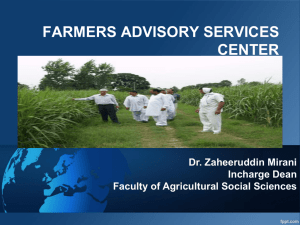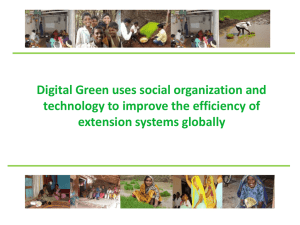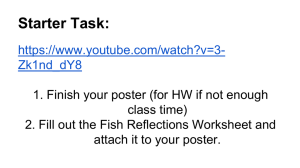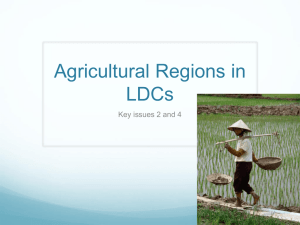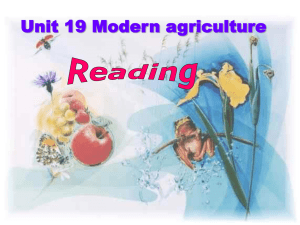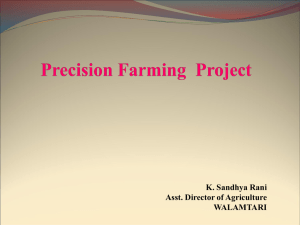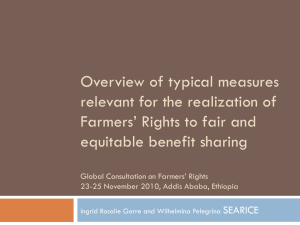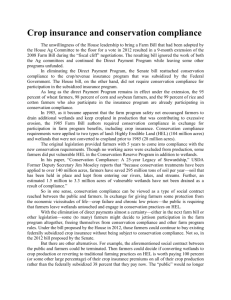An evaluation of communication strategies for scaling-up
advertisement
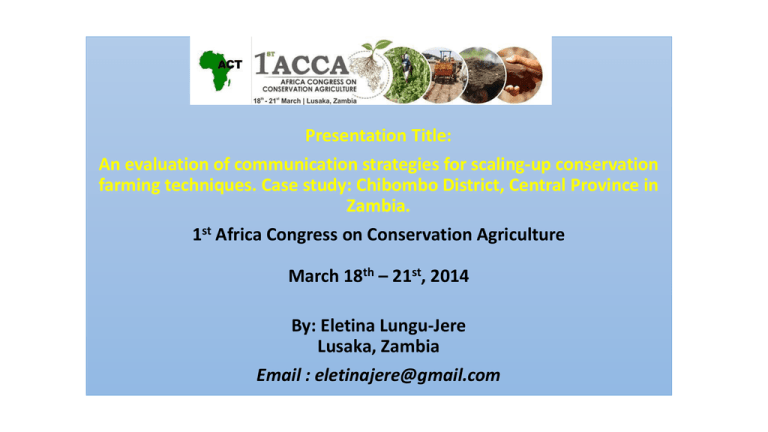
Presentation Title: An evaluation of communication strategies for scaling-up conservation farming techniques. Case study: Chibombo District, Central Province in Zambia. 1st Africa Congress on Conservation Agriculture March 18th – 21st, 2014 By: Eletina Lungu-Jere Lusaka, Zambia Email : eletinajere@gmail.com Theme : Building Entrepreneurship and Reliance Farming Systems Presentation Focus is on Sub Theme 7 : Increasing CA adoption how - innovative technologies approaches, infrastructure support and polices can drive greater adoption of conservation agriculture systems in Africa Presentation Outline 1.Background 2.Definitions 3.Chibombo Case Study : 3.1 Basic Information 3.2 The Objective of the Study 3.3 Scope and Focus 3.4 Methodology of the Study 3.5 Data Analysis 3.6 Findings 3.7 Conclusions and Recommendations Background • farmers experiencing hardships due to decreasing land productivity (1.2 mt/ha to 3.6 mt/ha) . • the decrease in land productivity is attributed to soil degradation due to poor farming systems, assorted with the massive use of chemical fertilizers for crop production. • result : low fertile and fragile soils due to reduced organic matter and carbon depletion leading to increased land desertification and stagnant crop yields • Soils being acidified due to depletion of organic matter and compacted soils hampered by plough pans following excessive ploughing that impedes both plant root and soil water penetration. • Low harvest, food insecurity, poverty and malnutrition. • In response to these factors : 1980 conservation farming/ conservation agriculture in was initiated in Zambia. Definitions • Conservation farming is in simple terms implies cropping using minimum tillage, permanent soil cover and diversification of crop species grown in sequence. Advantages : -Reduced soil erosion, better water infiltration, retention of crop reduces, input application in permanent planting stations, its cheap and rotating with nitrogen-fixing crops for fertility restitution to soils. • Communication is the process of sharing an idea, information and message with others in a particular time and space Basic Information on Chibombo • Chibombo District is one of the six (6) Districts in Central Province and about 90 Km from Lusaka it has great potential in agricultural production. • Agriculture is the main economic activity and ninety per cent (90%) of the District inhabitants depend on Agriculture for their livelihood. • The climate condition of the district is typically of agro ecological region II. The district receives rainfall averaging 800 mm to 1000 mm. • The climatic conditions are suitable for production of maize, cotton, sunflower, cowpeas, beans, groundnuts, paprika, soya beans, and tobacco etc • Several horticultural and vegetable crops, agro forestry tree plants such as Jatropher and Moringa. • Chibombo district has about 41,849 small holder farmers; 5,153 medium scale farmers and 256 commercial farmers mainly concentrated around Chisamba area. Over seventyfive (75%) of crop production in the district is done by small scale farmers. The Objective of the Study • To evaluate the communication strategies being used by the MAL and its’ development partners in disseminating information on CF to farmers so as to influence adoption of the CF technology. Scope and Focus • The study was drawn from two farming areas of Chibombo central and Mwachisopola area • The source of data was primary and secondary data • Study was conducted in 2012 • The focus was on the evaluation of the communications tools that the district offices use to facilitate the process of adoption of CF Methodology of the Study • The method used was qualitative (Focus Group Discussions, interviews, observations etc) and • Quantitative survey (Questionnaire of sample size -100) • Sampling Procedure: Adaptors, Dis-adaptors and Non-adaptors Challenges: - Good number of respondents were not able to read and write - Funding to the research was limited and done in a period of three months - Accommodation limited Data Analysis: - SPSS Data Analysis The results of the study were drawn from three farmer groups in relation to the adoption process of communication (Rogers 1962) Farmer Awareness stage category Interest stage Assessment stage Trial stage Adoption stage 1 Adaptors Individual is exposed to innovation but lack adequate information Individual becomes Individual decides interested and to apply the idea seeks for information Individual makes Individual decides full use of the to continue with innovation the technology 2 DisIndividual is exposed adaptors to the new idea Individual seeks information and inquires Individual apply the idea fully/ partial/not try Most individual will grow few lines 3 None Individual adaptors exposed/not exposed Individual not interested /puts a blind eye Mentally Individual convinces continues with him/herself it does his old system not work Individual discontinue with the idea Innovation not adopted Female farmers in Mwachisopola Dis-adaptor: Researcher with Village headman - Chipembele Findings •Low knowledge intake due inadequate information flow among farming communities. •Low levels of education •Wide spread farmer settlements •Poor access to information •Distant locations of information centres and poor road net work •Cultural phenomenon of resisting change (lack of appreciation of the social benefit of conservation farming). •Lack of adequate political will to promote conservation farming in its totality •Not all who farm are farmers Extension officer training farmers in Mwachisopola Extension officer instructing farmers in Chibombo district Conclusions • In conclusion small-holder farmers perceive communication through practical demonstration. • To scale up the adoption of CF there is need to develop the rural road net work. • The Standard CF manual developed by ZNFU should be translated into local languages and have more copies distributed. • NAIS should utilize the audio visual vehicles to create awareness through public announcements, radio broadcasts and documentaries. Recommendations • Raise the education levels of the farmers so that they can have an interest in print and electronic information • Open more Community radio stations in rural communities • MAL should develops a screening method to identify real farmers from opportunistic farmers • Government to speed up construction of rural roads so that they are passable • Establishment of communication centres • Government should employee more extension officers Zikomo-Thank you
